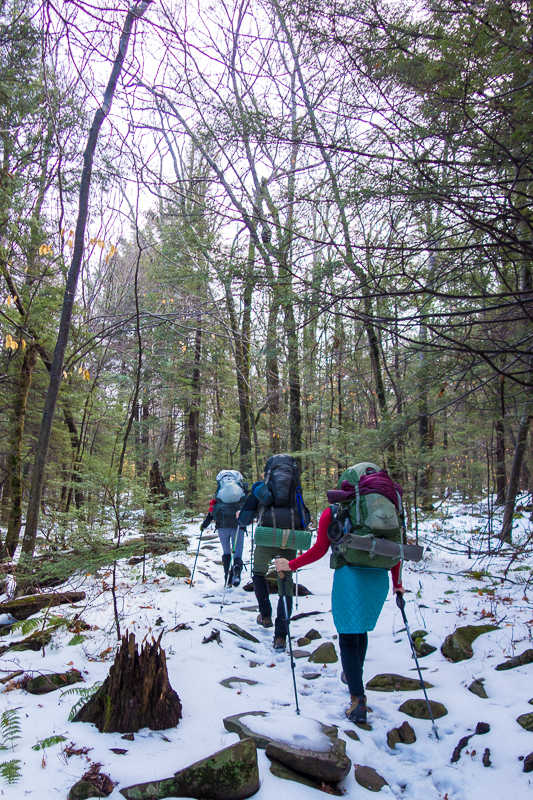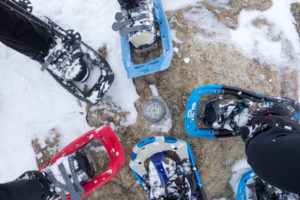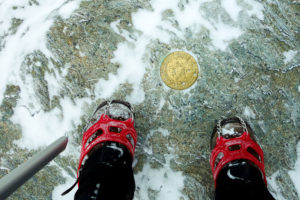This post was written by Caitlin Miller, GMC’s Group Outreach and Administrative Assistant and former Caretaker and Southern Field Assistant.
Winter is one of my favorite seasons to hit the trail. The views are crystal clear, there aren’t the crowds of summer, and the conditions create an exciting challenge. Plus, winter hiking is a great way to beat cabin fever. If you’ve never sat on top of Camel’s Hump on a blue-bird winter day, sipping hot cocoa and watching Lake Champlain shimmer in the distance, this season is the time to experience it.
Along with the many benefits of winter hiking, the cold weather and snowy conditions pose some tough challenges for both newbies and experienced trekkers alike. Below I’ve listed the biggest factors to consider when planning a winter hike and tips and tricks to have a safe and comfortable trek into the mountains of Vermont.
Cold
 It’s colder in Vermont in the winter than in the summer! I know, crazy, right? The temperature drops even further the higher up you go; usually about 5° every 1,000 feet of elevation. So, although it may be sunny and 40° in the valleys, up on Mt. Mansfield it could be cloudy and 25° – 30°. Even colder with wind-chill. To stay toasty while hiking in these temperatures and colder conditions, the most important step you can take is to dress like an onion! The key to staying warm is staying dry, so use a layering system to allow for sweating while still having dry layers to change into. Also, the old saying “cotton is rotten” could not be more true than in winter. Choose fabrics that will dry quickly such as wool and synthetics.
It’s colder in Vermont in the winter than in the summer! I know, crazy, right? The temperature drops even further the higher up you go; usually about 5° every 1,000 feet of elevation. So, although it may be sunny and 40° in the valleys, up on Mt. Mansfield it could be cloudy and 25° – 30°. Even colder with wind-chill. To stay toasty while hiking in these temperatures and colder conditions, the most important step you can take is to dress like an onion! The key to staying warm is staying dry, so use a layering system to allow for sweating while still having dry layers to change into. Also, the old saying “cotton is rotten” could not be more true than in winter. Choose fabrics that will dry quickly such as wool and synthetics.
- Base-Layer: This is the layer that sits against your skin. For my base-layer, I really like a thin wool long-sleeve or thermal long-john top. This is the layer that can get good and sweaty, but still dries quickly. Even if it’s freezing out, I will start hiking in only my base-layer because I know I’ll warm up quickly from exertion. I want to save my other layers so they stay dry.
- Mid-Layer: This is the layer that really traps your body heat against you and can keep you warm even if it gets slightly damp. I love fleece and heavier wool sweaters for mid-layers. I always bring two mid-layers with me: one to change into during snack breaks or if I get chilly while hiking. The other stays dry and in my pack until I reach the summit. That way, I’ll always have something warm and dry to change into.
- Insulating Layer: This is where those wonderful puffy jackets come into play! Down is the gold standard for hiking and backpacking because of its warmth-to-weight ratio; e.g. down is super warm but comparatively lightweight and packable. Perfect for shaving ounces off your pack weight! However, it’s important to keep your down clothing dry. Down clumps when it gets wet and offers zero warmth. There are synthetic puffy jackets which will be a bit heavier and may not be as warm, but will not fail if they get wet.
- Outer Shell: This is a crucial layer if it’s snowing (or sleeting or hailing or raining or slushing) or if you plan to hike in an exposed area. Rain jackets and hard shell jackets make great “shells” if they are waterproof and can protect you and your warm layers from precipitation and wind.
What you wear for pants is a bit more flexible, since your core is where most of your heat comes from. I like either wool or insulated synthetic leggings. Some people layer long-johns underneath hiking pants. Either way, I highly recommend also bringing rain pants or light-weight snow pants because the best part about winter hiking is getting to slide down on your butt after reaching the summit!
Snow
 Obviously, it gets snowy here in Vermont during winter. Although we love that fresh powder, snow creates unique challenges when setting off on the trail. An important way that snow transforms trails is by making them much harder to travel on. Deep snow can be exhausting to wade through and postholing can turn a short afternoon hike into an all-day ordeal. For example, two winters ago I hiked 5 miles in the Whites to Mizpah Hut. This hike that normally takes me 2 – 2 ½ hours in the summer turned into a 7-hour debacle because I was falling into snow up to my waist every other step. A good way to avoid the exhaustion and frustration of postholing is to bring along a good pair of snowshoes. But keep in mind that, even with snowshoes, allowing extra time for a winter hike is often necessary for having a safe and fun day on the trail.
Obviously, it gets snowy here in Vermont during winter. Although we love that fresh powder, snow creates unique challenges when setting off on the trail. An important way that snow transforms trails is by making them much harder to travel on. Deep snow can be exhausting to wade through and postholing can turn a short afternoon hike into an all-day ordeal. For example, two winters ago I hiked 5 miles in the Whites to Mizpah Hut. This hike that normally takes me 2 – 2 ½ hours in the summer turned into a 7-hour debacle because I was falling into snow up to my waist every other step. A good way to avoid the exhaustion and frustration of postholing is to bring along a good pair of snowshoes. But keep in mind that, even with snowshoes, allowing extra time for a winter hike is often necessary for having a safe and fun day on the trail.
Snow can make travel difficult in a different way by covering up important trail markers and signs. Luckily, the Long Trail is blazed in bright white paint, making it extremely easy to follow in winter…NOT. The white blazes (and blue blazes on side trails) can easily blend into snow, or be covered by heavy snowfall. A trail that you know in summer can also look completely different in winter. Always bring a map (and compass if you know how to use it) and pay extra attention to where you are. If you’ve never winter hiked before, I recommend starting with trails you know from summer or popular trails such as Burrows Trail on Camel’s Hump or Stowe Pinnacle Trail in the Worcester Range.
A Special PSA: Whiteouts are an extremely dangerous weather phenomenon that can happen above tree line in winter at any time. Although less of problem in Vermont, whiteouts in the White Mountains of NH and the Adirondacks of NY can prove overwhelming for the most experienced mountaineers. If you are planning to go above tree line and the weather takes a turn for the worse, turn around. The mountain will still be there another day and if you return when it’s sunny, the views will make the repeat hike worth it.
Ice
 Who doesn’t love walking up and down a treacherous luge run of sheer ice? I know winter hikers do, because that’s typically what trails turn into when the weather turns cold. Although it can make butt-sliding much more entertaining, ice on the trails is extremely hard to negotiate without the proper gear. Luckily, some enterprising outdoorsperson invented MICROspikes! MICROspikes are incredible boot accessories that slide on easily and give your boots the teeth of a hungry catamount. A friend once said, “The closest we’ll come to knowing what it’s like for a superhero to lose their super powers is when we take off our MICROspikes.” They’re my #1 recommended winter gear investment. You can go almost anywhere in Vermont with a sense of adventure and MICROspikes, and often they are necessary for getting up steeper pitches in winter conditions. Just be careful to avoid stepping on rocks or pavement in your precious spikes, as that can dull them and possibly break the chain.
Who doesn’t love walking up and down a treacherous luge run of sheer ice? I know winter hikers do, because that’s typically what trails turn into when the weather turns cold. Although it can make butt-sliding much more entertaining, ice on the trails is extremely hard to negotiate without the proper gear. Luckily, some enterprising outdoorsperson invented MICROspikes! MICROspikes are incredible boot accessories that slide on easily and give your boots the teeth of a hungry catamount. A friend once said, “The closest we’ll come to knowing what it’s like for a superhero to lose their super powers is when we take off our MICROspikes.” They’re my #1 recommended winter gear investment. You can go almost anywhere in Vermont with a sense of adventure and MICROspikes, and often they are necessary for getting up steeper pitches in winter conditions. Just be careful to avoid stepping on rocks or pavement in your precious spikes, as that can dull them and possibly break the chain.
If you don’t have MICROspikes or other kinds of winter traction (Yaktrax, NANOspikes, crampons, etc) and you run into an icy trail, keep in mind that going up ice is much easier than coming down. Don’t be that person who gets halfway up Sunset Ridge Trail before realizing you won’t be able to get down.
Shorter Days & Fewer People
The deep freeze. Cabin fever. The dark ages. These phrases help to convey the woe that settles over each New Englander once the winter winds begin to blow and the clocks are turned backward. Although winter hiking helps to combat the gloom we feel as we watch the sun disappear at 3:30 pm, winter hiking does not magically produce more daylight. That’s why it’s of the utmost importance to carry a headlamp and extra batteries with you on all hikes. Even if you’re only planning to head out for a quick two-miler up Stowe Pinnacle, the aforementioned conditions could throw a wrench in your plans and keep you out later than expected. Keep the batteries and headlamp in an inside pocket to keep them from dying too quickly.
Fewer people out hiking is a blessing of winter hiking, but if something goes awry it can quickly become a curse. To benefit from avoiding the masses rather than despair, come prepared by knowing your route, starting trailhead, destination, and mileage. Always have a map with you. Also, be sure to leave your itinerary with someone at home, including approximate return time. If you carry a cell phone (I should say, if you live in the 21st century), carry your phone in an inside pocket with your headlamp to preserve the battery.
If you prepare properly and use the right gear, winter hiking can be incredibly rewarding. However, things can go wrong. To learn more about winter-specific first aid worries and how to take care of yourself in the backcountry, come back next week for Winter Hiking Preparedness, Part Deux. You can also sign up for the Wilderness First Aid course we will be hosting at GMC in January. Wilderness First Aid is an incredibly informative course that’s a must-do for anyone who enjoys spending time in the woods.



















Great advice
Winter hiking requires carrying a light. Alkaline batteries die in the cold. Lithium batteries are more expensive, but the increase in safety is well worth the extra money.